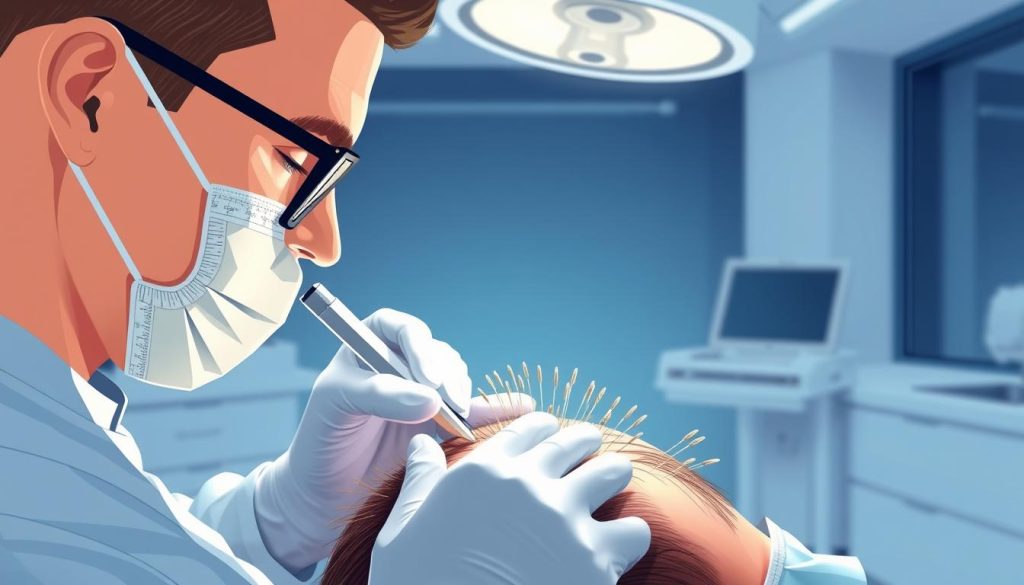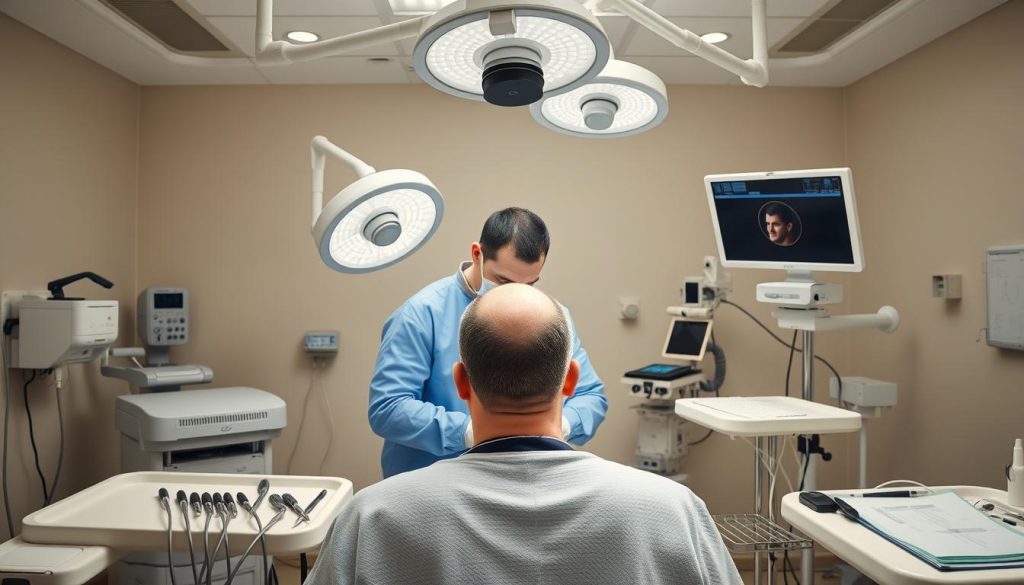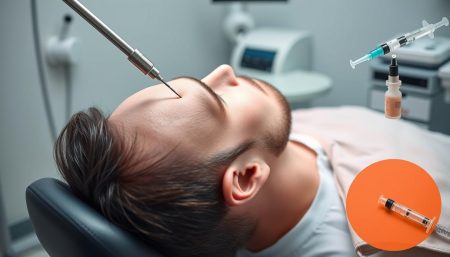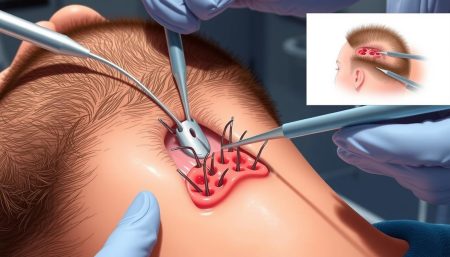Hair transplant surgery has become a key solution for hair loss. It’s not just a procedure; it’s a chance for renewal. With more people seeking natural-looking hair transplants, this field has grown significantly.
Now, hair restoration surgery is a leading cosmetic procedure. It offers a detailed solution, where each hair follicle is placed with care, just like nature.
A successful hair loss treatment depends on the surgeon’s skill and dedication. It’s a task that needs precision and understanding of each patient’s goals. Patients trust these experts, hoping for results that blend with their natural hair.
So, choosing the right specialist for your hair restoration surgery is a big decision. It’s a step towards feeling more confident and positive about yourself.
Exploring expert hair transplant surgery reveals its power to boost one’s appearance and confidence. The journey from baldness to full hair is made possible by skilled surgeons and advanced techniques. It shows how science and art come together to bring back youth and vitality.
Understanding Hair Transplant Surgery
Exploring hair restoration treatments reveals the importance of hair transplant surgery. It offers lasting solutions for hair loss and has changed medical technology and patient experiences. This surgery is a top choice for those wanting permanent, natural-looking hair.
Defining Hair Loss Treatments
Today, many hair loss treatments exist, from simple creams to advanced surgeries. Hair restoration surgery is chosen by those seeking a lasting fix. It moves hair from full areas to thin or bald spots, stopping hair loss forever.
The Evolution of Hair Restoration Procedures
Early hair restoration methods were simple but have evolved into precise, natural-looking surgeries. The shift from basic hair plugs to advanced follicular unit extraction shows big progress in this field.
The table below shows how hair restoration methods have changed over time:
| Time Period | Method | Characteristics |
|---|---|---|
| 1950s-1980s | Hair Plugs | Large grafts, noticeable results |
| 1990s | Mini/Micro Grafting | Smaller grafts, less detectability |
| 2000s to Present | Follicular Unit Extraction (FUE) | Individual follicles, natural appearance |
Recent advances in hair transplant surgery offer better results and less pain. They also make recovery faster, making it a top choice for severe hair loss.
Choosing the Best Hair Transplant Surgeon
Finding the best hair transplant surgeon is more than just a search. It’s about finding someone who can change how you look and feel. When choosing a hair restoration specialist, look at their skills, experience, and past results.

Start by checking their credentials, like board certifications and medical society memberships. A best hair transplant surgeon will have a strong portfolio. They should have “before and after” photos that show what they can do. Look at these to see if their style matches what you want.
Also, read what past patients say. Their stories can tell you about the surgeon’s care and skill. These reviews help you know what to expect from your own treatment.
Guides suggest visiting the clinic in person. This lets you meet the doctor and see the technology they use. You can also check how clean and professional the clinic is.
| Criteria | Importance |
|---|---|
| Credentials | High – verify board certifications and professional memberships |
| Before and After Gallery | High – assess aesthetic results and style consistency |
| Patient Testimonials | Medium – obtain insights into personal experiences and satisfaction |
| Facility Visit | Medium – evaluate clinic’s technology, cleanliness, and staff professionalism |
Choosing a surgeon is a big decision. It should be based on careful research and feeling comfortable with the doctor’s style and results. Choosing the best hair restoration specialist is key to looking and feeling better.
The Hair Transplant Surgery Procedure Explained
Exploring the hair transplant surgery, like the FUE procedure, shows how it aims for natural results. The steps before and during the surgery are key to its success. Here’s what you need to know.
Preparing for Your Procedure
Getting ready for a hair transplant starts with a detailed consultation. This checks if you’re a good fit for the FUE procedure or other options. You’ll get advice on pre-surgery prep, like changing medications and scalp treatments, to get the best results.
Step-by-Step: The Day of Surgery
The surgery day is designed for comfort and efficiency. Here’s a step-by-step guide to help you understand the process:
- Arrival: You arrive at the clinic, where you’re prepped for surgery. This includes cleaning your scalp and giving local anesthesia.
- Extraction Phase: Special tools are used to carefully take out individual hair follicles from the donor area. This is a key part of the FUE procedure.
- Implantation Phase: Each follicle is then placed in the thinning areas, following a planned hairline or coverage plan.
- Post-Procedure Care: Right after, you’ll get instructions on how to care for yourself to help the healing and growth of the transplanted hair.
| Phase | Description | Duration |
|---|---|---|
| Preparation | Initial setup, anesthesia, and scalp preparation | 1-2 Hours |
| Extraction | Follicle removal using FUE methods | 2-4 Hours depending on graft count |
| Implantation | Placement of follicles into thinning areas | 2-3 Hours |
| Post-Procedure | Immediate care and instruction briefing | 1 Hour |
The hair transplant surgery, including the FUE procedure, needs careful planning and precise steps. Knowing each part helps you prepare better and ensures the best results.
Benefits of Follicular Unit Extraction (FUE)
Follicular unit extraction, or FUE, is a leading method in hair restoration. It’s known for being gentle and quick, with little pain. This method doesn’t need big cuts, making it a top pick for those wanting to look good without scars.

FUE has many benefits that make it better than older methods. It leaves almost no scars, so you can cut your hair short without showing scars. This is a big plus for those who want to keep their hair looking natural.
- Quick Recovery: FUE helps you heal fast, unlike older methods that take longer.
- Reduced Scarring: It makes scars almost invisible, which is key for those who value their looks.
- Versatility: FUE works well on different hair types and patterns, making it a good choice for many.
- Comfort: People usually feel less pain after FUE because it’s a gentle method.
In short, FUE does more than just restore hair. It also improves your life and comfort. As FUE becomes more popular, it will likely change hair restoration even more. It offers hope to those dealing with hair loss.
Comparing Hair Restoration Techniques
When looking into hair restoration, it’s key to know the differences between FUE and FUT. These methods are big in hair transplantation. They have different benefits and things to think about. This part will help you understand each one better.
FUE vs. FUT: What’s the Difference?
FUE and FUT are two ways to get hair follicles. FUE takes out individual follicles with special tools. This means less scarring and a quicker recovery. On the other hand, FUT takes a strip of scalp tissue. It leaves a line scar and takes longer to heal but can give more hair in one go.
| Feature | FUE | FUT |
|---|---|---|
| Scarring | Minimal, scattered dots | Linear scar at donor site |
| Procedure Time | Longer, individual extraction | Shorter, strip extraction |
| Recovery Time | Shorter, less invasive | Longer, due to suture |
| Cost | Generally higher | Less expensive |
| Best for | Smaller areas, detailed work | Larger areas, higher density |
Choosing between FUE and FUT depends on your hair loss, donor hair, and healing. A detailed comparison of hair restoration techniques can help you decide.
Latest Innovations in Hair Transplant Technology
Hair transplantation is getting better with new tech. Robotic FUE makes it faster and more precise. Microscopic tools in FUT help grafts survive better.
Knowing about these new techs helps patients set realistic goals. It makes choosing a hair restoration method easier.
The Hair Transplant Surgery Recovery Timeline
Recovering from a hair transplant is a key phase. Proper care is essential for the best results. The hair transplant recovery timeline differs for everyone. Yet, a common healing and hair growth pattern is expected.
Knowing these phases and following post-operative care helps a lot. It ensures a smooth recovery.
Immediately After Surgery: What to Expect
Right after the surgery, you’ll notice some changes. Expect mild swelling, redness, and sensitivity in the treated areas. Some discomfort is normal, but it can be managed with the right medication.
Tips for a Smooth Recovery Process
Following the recommended care is key for a smooth recovery. Here are some tips to help:
- Avoid strenuous activities for at least a week to minimize swelling.
- Keep your head elevated, even when sleeping, to help reduce swelling.
- Follow your surgeon’s guidelines on shampooing, which generally starts a few days after surgery to keep the scalp clean and reduce the risk of infection.
Also, keep up with follow-up visits with your surgeon. This helps monitor your recovery and hair growth.
| Time Post-Surgery | Expected Recovery Event |
|---|---|
| 24 Hours | Dressing removal and first hair wash |
| 1 Week | Return to non-strenuous work, resolution of major swelling |
| 1 Month | Noticeable shedding of transplanted hairs; beginning of natural growth phase |
| 3-6 Months | Initial signs of new hair growth |
| 1 Year | Full maturity of hair growth |
Having a realistic view of the hair transplant recovery timeline is important. Following post-surgical expectations greatly impacts results. Always talk to your hair restoration specialist for personalized recovery tips.
Managing Hair Transplant Surgery Costs
Understanding the hair transplant cost is key for those thinking about it. Several factors affect the price, like hair loss severity, procedure type, and clinic location.
Many worry about paying for hair transplant cost. Luckily, financing hair restoration surgery is available. Clinics offer payment plans for easier monthly payments. It’s smart to talk about these during your first visit.
Here’s a table to help you understand what different procedures might cost:
| Procedure | Average Cost | Notes |
|---|---|---|
| FUE (Follicular Unit Extraction) | $4,000 – $15,000 | Depends on the number of grafts |
| FUSS (Follicular Unit Strip Surgery) | $3,000 – $12,000 | Cost-effective for larger areas |
It’s also good to know about insurance and hair transplant surgery. Most insurance doesn’t cover it, but some might if it’s for a medical reason.
By understanding the hair transplant cost and looking into financing hair restoration surgery, you can plan your budget better. This way, you can move forward with confidence.
Realistic Expectations: Hair Transplant Before and After
When you think about getting a hair transplant, it’s important to know what to expect. Looking at hair transplant before and after pictures helps a lot. These images show how a good hair transplant can change your look, aiming for realistic hair transplant results.
Case Studies: Success Stories
Every hair transplant is different, but learning from others can help. By seeing how people have changed before and after, you get a better idea of what to expect. These stories show how more hair can make you feel more confident and happy.
Visual Evidence: The Importance of Before and After Photos
Seeing is believing when it comes to hair transplants. Hair transplant before and after photos prove how well these procedures work. They show not just the results but also the skill of the surgeons.
To show how much change is possible, here’s a comparison of patient results:
| Timeframe | Hair Density Before | Hair Density After | Patient Satisfaction Level |
|---|---|---|---|
| 6 Months | Low | Medium | High |
| 1 Year | Medium | High | Very High |
The table shows how people’s hair and happiness can change over time. It’s clear that there’s a big improvement in both looks and feelings. This evidence helps new patients understand what they might experience, making them more confident in the process.
Hair Transplant Surgery for Different Hair Types
When it comes to hair transplant for various hair types, the approach is anything but uniform. Each hair type, from curly to straight, thin to coarse, needs a unique surgical approach. This ensures the best results. It’s all about achieving a natural look that matches the patient’s features.
Surgeons look at many factors, like hair texture and scalp health, to customize the transplant. For curly hair, they carefully angle the transplanted follicles. This helps the hair grow naturally and improves the surgery’s success.
- Determining the right surgical technique based on hair type
- Adjusting follicle placement for natural growth patterns
- Using specialized tools to handle different hair textures
Genetic and cultural backgrounds also matter in personalized hair restoration. These can affect hair characteristics and growth. This makes the procedure more complex but also allows for tailored treatments.
| Hair Type | Challenges in Transplant | Custom Approaches |
|---|---|---|
| Curly | Complex follicle patterns | Angular placement technique |
| Fine | Visibility of scalp | Denser placement strategy |
| Coarse | Scalp visibility reduction | Strategic follicular unit distribution |
The importance of hair transplant for various hair types in hair restoration cannot be overstated. Thanks to new techniques and understanding of hair, surgeons can now achieve better results. These results are not only effective but also look great.
Potential Risks and How to Avoid Them
Hair transplant surgery is known for its success and great results. But, it’s important to know about the hair transplant surgery risks and side effects. Knowing these can help you prepare and take steps to avoid problems.
Common Side Effects of Hair Transplant Surgery
Getting a fuller hairline might come with some side effects. You might see redness, swelling, and feel a bit uncomfortable at the site. These usually go away in a few days. But, rare side effects like infection or scarring can happen.
How to Minimize Complications
To get the best results from hair restoration, you need skilled techniques and proactive steps. Here are some tips:
- Choose a surgeon who is certified in dermatology or cosmetic surgery. Their experience can lower hair transplant surgery risks.
- Follow all instructions before and after the surgery. This helps your healing and lowers the chance of problems.
- Have realistic expectations about the results and recovery time. This can help you avoid stress and protect the treatment area.
Learning what to expect before, during, and after the surgery can also help avoid complications.
| Potential Complication | Prevention Strategy | Immediate Action |
|---|---|---|
| Infection | Maintain cleanliness, use prescribed antibiotics | Consult your surgeon if signs of infection appear |
| Excessive Swelling | Use cold compresses, keep head elevated | Contact healthcare provider if swelling persists |
| Scarring | Choose an experienced surgeon, ensure proper technique | Discuss with your doctor for possible treatments |
In conclusion, while side effects are part of hair transplant surgery, their impact can be lessened. This is through careful planning, expert care, and taking informed actions.
Why Expert Hair Transplant Surgery Matters
Choosing a surgeon with a lot of experience in hair transplant procedures is key for the best results. The skill of the surgeon is very important. It ensures each follicle is placed to look natural, which greatly affects the final look.
The Importance of Experience and Skill in Natural Results
The surgeon’s skill greatly affects the success of the transplant. It impacts the hair’s density, angle, and the hairline’s look. Surgeons who know a lot about hair restoration and facial anatomy usually get the best results. Their work looks natural and effective.
Testimonials: The Patient’s Perspective
Testimonials from past patients offer great insights into the effects of expert hair transplant surgery. These stories show how a skilled surgeon can change lives. They talk about better hair growth and increased confidence and satisfaction.
Post-Operative Care and Maintenance
Effective post-operative care is key for a successful hair transplant. This includes careful management of the surgical area and following a specific hair care plan. This helps keep the transplanted follicles healthy and sustainable. Let’s look at the important parts of post-operative care and share tips for hair transplant maintenance.
After surgery, the scalp needs special care for hair growth and healing. Swelling and sensitivity are common but can be managed with the right care. Healthcare professionals will guide you on how to do this.
- Avoid washing your hair for at least 48 hours after surgery.
- Sleep with your head elevated to reduce swelling.
- Avoid direct sunlight and strenuous activities for the first few weeks.
- Use medicated shampoos and serums as prescribed to aid the healing process.
Hair transplant maintenance is not just about immediate care after surgery. It also includes long-term strategies to keep both transplanted and existing hair follicles healthy.
| Time Post-Surgery | Recommended Care | Reason |
|---|---|---|
| First month | Supervised follow-up visits | To monitor healing process and adjust care regimen if necessary |
| 1-6 months | Use of gentle hair care products and treatments | To support the delicate new hair and promote strength |
| 6 months onwards | Regular check-ups and maintenance sessions | To ensure lasting results and address any long-term concerns |
In short, post-operative care lays the groundwork for a successful outcome. Ongoing hair transplant maintenance is vital for long-lasting results. By following these steps, patients can enjoy their hair transplants for a long time.
Hair Transplant Surgery Aftercare: Tips and Best Practices
Starting a hair restoration journey needs more than just surgery. It also requires careful aftercare. Keeping the transplanted hair healthy means focusing on hair transplant aftercare, scalp nourishment, and long-term hair care. Success comes from a detailed care plan that boosts scalp health and hair strength.
Nourishing Your Scalp for Optimal Growth
Looking after your scalp is key to your new hair’s health. Right after surgery, your scalp might be sore and easily irritated. Using soft, nourishing shampoos and conditioners can help ease pain and aid healing. Adding scalp massages with vitamin E oil can also help blood flow, creating a great setting for hair growth.
Long-Term Hair Care Post-Transplant
After the transplant, your hair care should protect the new growth. Stay away from harsh chemicals and heat styling tools that can harm your hair. Instead, choose natural styling and regular trims to keep your hair healthy. Eating a diet full of proteins, iron, and omega-3 fatty acids also helps keep your hair strong from the inside.
| Post-Transplant Care Aspect | Recommended Practices | Expected Benefits |
|---|---|---|
| Gentle Cleansing | Use sulfate-free shampoos | Less irritation and preserved moisture levels |
| Nutritional Support | Incorporate dietary supplements as advised by healthcare provider | Supports overall scalp and hair health |
| Minimal Styling | Avoid heat and chemicals; opt for natural styling | Prevents damage to new follicles and promotes healthier growth |
Hair Transplant Surgery: Ensuring a Natural Look
Many people want to restore their hair and look natural. To achieve this, the surgeon’s skill and the procedure’s precision are key. They design the hairline and place follicles at the right angle to mimic natural growth.
This focus on detail and understanding of hair transplant aesthetics leads to results that look real. Patients can feel confident in their new look.
Following the right care after surgery is also important. Surgeons use advanced techniques and patients must follow a care plan. This teamwork between the surgeon and patient is what makes the surgery a success.
It’s all about blending medical skill with care after the surgery. A delicate balance is needed to achieve a natural look. Choosing a surgeon who values this balance is essential for a successful hair transplant.
In the end, a successful hair transplant is one that looks like your own hair. It’s about planning carefully and following up with the right care. This ensures the new hair blends seamlessly with your existing hair, creating a natural look that’s uniquely yours.
FAQ
Q: What is expert hair transplant surgery and what results can I expect?
A: Expert hair transplant surgery moves hair follicles from one area to another. It aims to make your hair look natural again. You’ll see your hair grow back over time, usually in a few months.
Q: How have hair loss treatments and hair restoration procedures evolved?
A: Hair treatments have changed a lot. Now, we have surgeries that can fix hair loss for good. These surgeries are better and faster, thanks to new technology.
Q: How do I choose the best hair transplant surgeon?
A: Look for a surgeon with good skills and lots of experience. Check their before and after photos. Also, read what other patients say and make sure they’re certified.
Q: What is involved in preparing for a hair transplant surgery procedure?
A: Before surgery, talk to your surgeon about what to expect. They’ll tell you about risks and how to care for yourself after. You might need to stop taking certain medicines or change your diet.
Q: What are the benefits of Follicular Unit Extraction (FUE)?
A: FUE is less invasive than old methods. It means less scarring and quicker healing. You can also style your hair more freely after surgery.
Q: How do FUE and FUT differ in hair restoration techniques?
A: FUE and FUT are two ways to transplant hair. FUE takes single follicles without a big scar. FUT uses a strip of scalp, leaving a scar. FUE is faster and lets you style your hair sooner.
Q: What does the hair transplant surgery recovery timeline look like?
A: Right after surgery, you might feel swollen and sore. You can go back to light activities in a week. It takes a few months for the hair to grow back fully.
Q: How can I manage hair transplant surgery costs?
A: To save money, think about how much hair you need to transplant. Look for financing options and talk to your insurance. Some clinics offer deals, so ask about those too.
Q: Why is it important to have realistic expectations for hair transplant before and after results?
A: Having realistic expectations helps you be happy with the results. Looking at before and after photos can give you a good idea of what to expect. It helps avoid disappointment.
Q: How does hair transplant surgery cater to different hair types?
A: Surgeons tailor the surgery to fit your hair type. They consider your hair’s texture and curl. This makes the results look natural and improves the surgery’s success.
Q: What are common side effects of hair transplant surgery, and how can I minimize complications?
A: You might experience swelling, bruising, and numbness. To avoid problems, choose a skilled surgeon and follow their instructions. Knowing the signs of infection is also important for a smooth recovery.
Q: Why does expert hair transplant surgery matter in achieving natural results?
A: An experienced surgeon is key to natural-looking results. Their skill and planning are what make the hairline and density look right. Past patients’ testimonials can show a surgeon’s ability.
Q: Why is post-operative care and maintenance important after hair transplant surgery?
A: Proper care helps your hair grow back well. It keeps the scalp clean and protects the new hair. Taking care of your hair after surgery is important for lasting results.
Q: What are important aftercare tips and best practices following hair transplant surgery?
A: Keep your scalp clean and avoid the sun. Don’t do too much exercise and follow your surgeon’s hair care instructions. Eating right and avoiding smoking and alcohol helps your hair grow.
Q: How can I ensure my hair transplant surgery results in a natural look?
A: Work with a surgeon who focuses on natural results. Follow their care plan to help your hair heal and grow. Being clear about what you want and setting realistic expectations also helps.


















